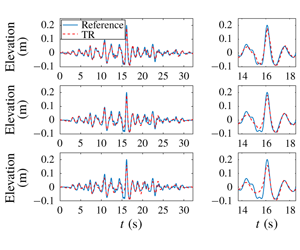Article contents
Experimental reconstruction of extreme sea waves by time reversal principle
Published online by Cambridge University Press: 09 December 2019
Abstract

We report an experimental study of the reconstruction of real-ocean rogue waves in a laboratory environment using the time reversal (TR) methodology (Chabchoub & Fink, Phys. Rev. Lett., vol. 112, 2014, 124101). Three different rogue wave measurements are used to validate the TR approach. The generation and accurate control of target free-surface profiles in a unidirectional wave flume using standard techniques, such as the New Wave theory (Tromans, Anaturk & Hagemeier, Proceedings of the First International Offshore and Polar Engineering Conference, 1991, pp. 64–71), are fairly challenging, especially for very steep and, thus, highly nonlinear extreme waves. The TR method, making use of the time reversibility of wave propagation and symmetry of the governing hydrodynamic equations of motion, leads to a simple two-step experimental procedure, the accuracy of which is investigated in this paper. The use of the TR procedure requires the appropriate Froude scaling in designing the model-scale experiments. The present study represents the first validation of the TR method to realistic irregular seas containing rogue waves. Three extreme wave profiles are tested to assess the applicability of the TR scheme to different wave configurations taking into account variable characteristics. This includes the famed New Year wave. The accuracy of the TR method is demonstrated with varying wave steepness values and propagation distances of the reverse reconstruction. It is demonstrated that the unidirectional TR reconstruction is robust, even in the presence of unavoidable wave breaking, known to be an irreversible process within the framework of any wave hydrodynamic evolution equation, and independently of complex environmental conditions or focusing mechanism at play in the sea.
- Type
- JFM Papers
- Information
- Copyright
- © 2019 Cambridge University Press
References
- 15
- Cited by


